Sun 12 Mar 2023
A PI Movie Review by David Vineyard: THE SPIDER (1945).
Posted by Steve under Mystery movies , Reviews[5] Comments
THE SPIDER. 20th Century-Fox, 1945 Richard Conte, Faye Marlowe, Martin Kosleck, Kurt Kreuger, Mantan Moreland, John Harvey, Ann Savage . Screenplay by Jo Eisenger & Scott Darling based on the play by Fulton Oursler (Anthony Abbott) and W. Scott Darling. Directed by Robert Webb.
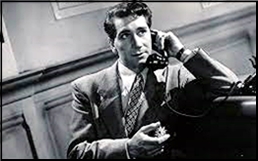
Well done if minor film noir from fairly early in the game, opening with an overhead panning shot in the streets of New Orleans where Lila Neilson (Faye Marlowe) walks toward a dark staircase with a white painted sign that reads “Cain and Conlon – Private Investigators” as she tells us that Cain (Ann Savage), the distaff side of Cain and Conlon, has approached her to tell her that her partner Chris Conlon (Richard Conte) has information about the death of Lila’s sister.
Conlon’s manservant, Mantan Moreland, directs her to a cafe where Conlon is holding forth with his reporter friends on a dull night. Conlon is an ex-cop, a bit too slick for the taste of his ex-cop buddies and about to run afoul of that reputation for running close to the edge.

There is a nice touch in the scene where Moreland confronts Lila in the dark hallway outside Cain and Conlon’s office door and when he walks away w,e notice a shadowy figure with a hat pulled low step out of the deeper shadows.
For a fairly short B-film, the plot is fairly complex, involving a phony psychic called the Spider Woman whose scam was involved in Lila’s sisters death and Ernest, The Great Garrone (Kurt Krueger) her partner and his top man Martin Kosleck, and something Cain has uncovered in documents she is trying to get to Conlon.
When Cain meets Conlon at his apartment she is killed there, and Conlon, knowing the police will tie him up with red tape accusing him, transports her body to her own apartment to be found.
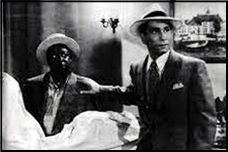
Of course when the police discover tha,t he is on the run.
In fairness, however stupid that seems, it is standard private eye behavior in print and on screen.
The playlike structure shows, and of course there is a bit of the usual shtick with Moreland as comedy relief (which for once isn’t the best thing in the film), but on the whole this is a decent film noir outing that benefits from the attractive cast and particularly Conte as a slick private detective right out of the pulps.
Conte would later play Sam Spade in a television adaptation of a Hammett story and while Conlon is no Spade, he is still well within the slick but not as bright as he thinks he is tradition of movie eyes.
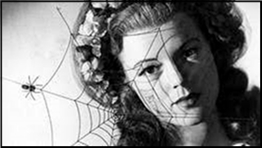
If there is a problem, it’s the casting alone is enough to give away who the culprit is, but considering the quiet menace the film manages to create that is a minor complaint. The details getting to the reveal at the end are done well and involving enough you probably won’t mind.
The private eye tropes had been around on the rough edges of movies since the early Thirties and films like Private Detective 62 and Mister Dynamite (suggested by stories by Raoul Walsh and Dashiell Hammett respectively), not to mention the Ricardo Cortez Maltese Falcon adaptation, though it is later in the Thirties before the more modern take starts to take form (in Private Detective 62 William Powell is a disgraced diplomatic agent who uses his skills to prey on women cheating on their husbands more than investigates crimes), helped along by the Thin Man films and cemented by John Huston’s The Maltese Falcon and the Lloyd Nolan Michael Shayne films. Murder My Sweet and The Big Sleep nailed the final screen image of the private eye for good in terms of the film version of the trope.

The evolution of the private detective in film from the dumb fat guy with cigar and bowler hat to the slicker version we are familiar with is fairly interesting with some unusual side streets like Nigel Bruce’s Cockney private detective in Murder in the Caribbean. The earliest incarnations were fairly unscrupulous pseudo crooks usually played by the likes of William Powell, Edmond Lowe, or Ricardo Cortez evolving through the Thirties into more acceptable social types like Preston Foster’s Bill Crane, Powell’s Nick Charles, Bogart’s Spade, and Nolan’s Shayne all the way down to Dick Powell and Bogie’s Philip Marlowe. Conte’s Chris Conlon is very much in that transition stage.
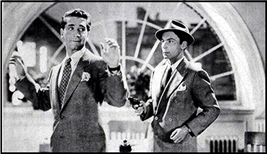
I don’t want to oversell this. It is low budget, cliched (but good cliche). It does the tropes well, the cast is good, and the main disappointment is we don’t get more of Ann Savage’s Flo Cain as a smart female private eye. There was a good concept there that got thrown away in favor of a fairly standard story, however hard I try to review the movie they made and not the one they should have made.
Film Noir was still in its formative stages at this point and this one captures some of the feel and look surprisingly well for its budget, with several actors who will play a role in the genre as it develops. I don’t know if it is on DVD, but you can find it on YouTube or Internet Archive in a decent print in several formats to watch or download in Community Videos. This one is definitely in Public Domain so there is little worry it violates anyone’s rights.
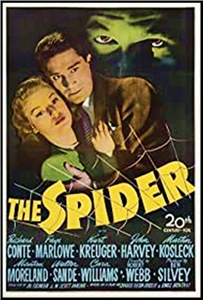
March 12th, 2023 at 10:11 pm
For Dan Stumpf’s perspective on this same film, posted come time earlier on this blog, here’s the link:
https://mysteryfile.com/blog/?p=33864
March 13th, 2023 at 12:41 am
Dan goes into all the writers who didn’t get screen credit for the film, while I just listed the three who did. Like him I wonder that it isn’t better with so many well-known contributors.
I liked it more than Dan by a little, but only because I appreciated how well it handled the Film Noir look at such an early point and hit all the familiar notes. You can’t fault it on the atmosphere of New Orleans.
We both point out what a heavy-weight cast this has.
March 13th, 2023 at 4:26 am
Why didn’t Conlon’s manservant move the body? That’s what manservants are for.
Presumably you can’t get the staff nowadays.
Colson seems very unlike Spade – Spade with a manservant! – and he doesn’t seem to bothered about his partner getting killed either, which is the trigger for Spade in The Maltese Falcon.
March 13th, 2023 at 8:29 am
Roger, it’d be hard for any guy to mourn the loss of a partner like Ann savage.
March 14th, 2023 at 7:31 pm
Conte’s Conlon is a bit of a goof off early in the film, more interested in holding court in the bar with his buddies than doing his job. He’s clearly no Sam Spade though as I said he played Spade in an hour-long anthology episode.
I’ve seen it referred to as an adaptation of THE MALTESE FALCON and also as an adaptation of the short “Too Many Have Lived.” I don’t know if a kinescope exists. There is also a lost Philip Marlowe with Dick Powell of THE LONG GOODBYE which may no longer exist.